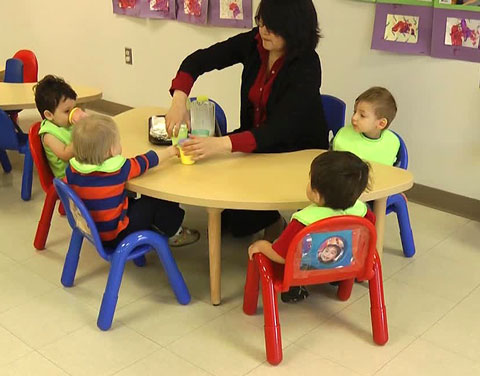About this video
This video (consisting of three different clips) takes place in an infant/toddler room of a university laboratory child care center and preschool during snack time. Jayden (20 months), Mason (21 months), Spencer (20 months), Ryder (15 months), and the teachers, Sui Ping, Cassie, and Daniela, are preparing for and eating snacks. Cassie is singing with the boys who are ready and sitting at the table while Sui Ping helps wash hands and Daniela wheels the snack cart into the room. This interaction demonstrates the teachers’ cooperation and understanding of their roles in classroom management. It also demonstrates appropriate teacher-child interactions at the snack table.
Video
Transcript
Ryder, Spencer, and Mason are sitting at the table waiting for snack. Cassie (teacher) is engaging them with a song while they are waiting for Jayden to join them.
Cassie: … sailing. The green balloon goes sailing, sailing…
Ryder: Pop!
Cassie: Pop! How ‘bout … let’s do … blue. The blue balloon goes sailing …
Daniela enters with the snack cart.
Daniela: Morning. How are you?
Cassie: … sailing, sailing. The blue balloon goes sailing, sailing, Pop!
The boys bang on the table in excitement.
Jayden sits down to join the three boys at the table.
Ryder and Spencer: Pop, pop…
Daniela: We have snack!
Cassie: I think it’s oatmeal!
Sui Ping has joined the boys at the table and is filling the cups with milk, putting lids on the cups, and passing out bowls of oatmeal.
Cassie (offscreen): Daniela is coming back.
Sui Ping: Thank you for patience.
Cassie (offscreen): Well the girls must have decided to sleep in today, boys.
Sui Ping: Uh huh.
Spencer: More.
Sui Ping: Yes. This is yours. Enjoy!
Spencer: Uh oh.
Sui Ping: Uh oh, what happened? OK. Next. Oatmeal. (She uncovers the oatmeal). Ooh…
Daniela enters the room.
Daniela: Hi. How’s the oatmeal?
The boys are busy eating.
Sui Ping: Good job.
Illinois Early Learning Guidelines for Children Birth to Age Three and strategies that caregivers used
Self-Regulation: Foundation of Development
Emotional Regulation
Children demonstrate the emerging ability to identify and manage the expression of emotion in accordance with social and cultural contexts.
- Strategies for interaction (16-24 months): Describe feelings when interacting with children
- Action: As Sui Ping hands the cup to Mason, she thanks him for his patience.
Developmental Domain 2: Physical Development & Health
Self-Care
Children demonstrate the desire and ability to participate in and practice self-care routines.
- Strategies for interaction (16-24 months):
- Provide support and independence as the child learns new skills
- Provide the child with opportunities to work through mastering self-help skills
- Allow the child time to begin to master some self-help skills
- Action: The boys were drinking from the cups and eating with spoons, if able. Those who did not use a spoon were allowed to use their hands. Also, Sui Ping assisted Jayden in washing his hands.
Developmental Domain 4: Cognitive Development
Memory
Children demonstrate the ability to acquire, store, recall, and apply past experiences.
- Action: When singing a familiar song with the boys while they were waiting for snack, Cassie paused to give the boys time to say “pop.”


